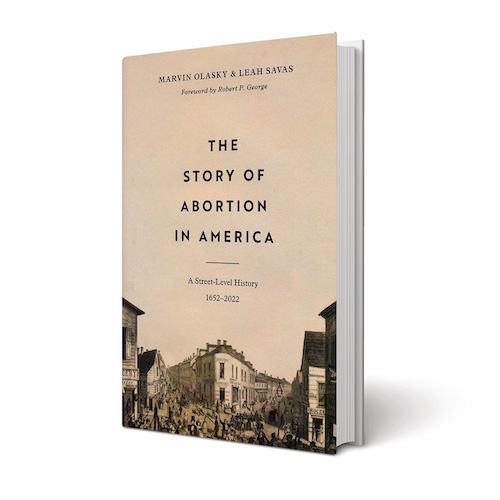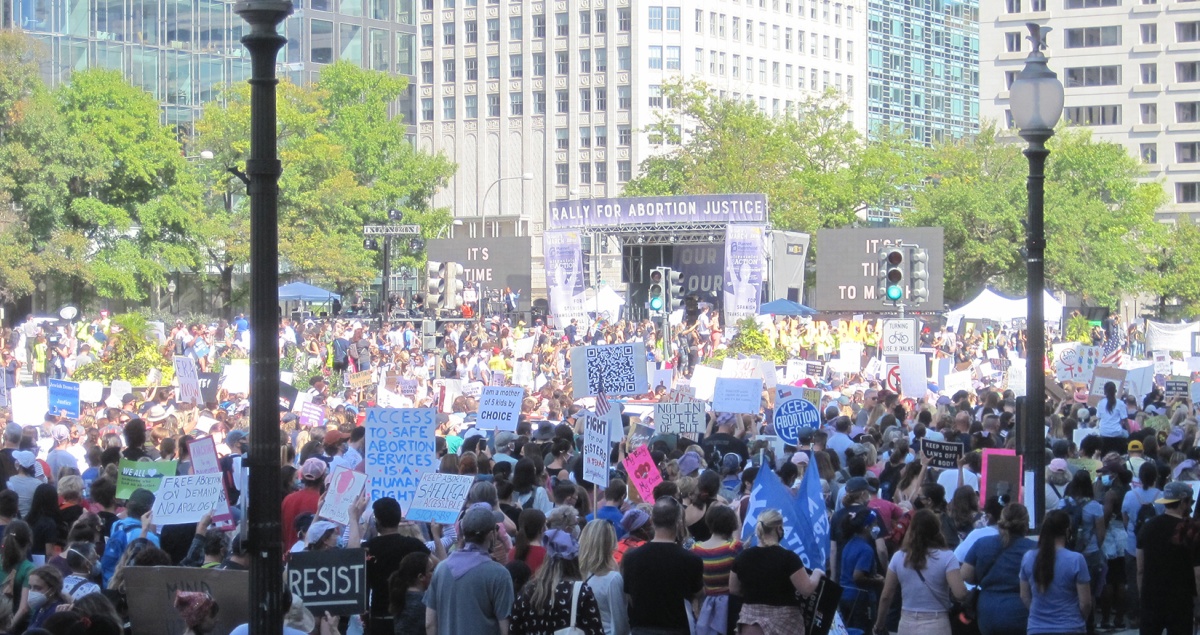Abortion solves problems. This is what its advocates promised in the years leading up to the Supreme Court decision in Roe v. Wade, which invented a supposed constitutional right to abortion. This is what its advocates continue to argue today in the wake of the Court’s 2022 decision reversing Roe. Abortion is a solution.
The history of abortion in America started not in the 20th century but virtually at the nation’s advent. It’s a gruesome tale that many have tried to sanitize through deflection and misrepresentation. It’s time the whole story was told.

By Marvin Olasky and Leah Savas
(Crossway, 2023)
Rarely do you encounter a supporter of legal abortion who sings its praises as an act of killing. Indeed, it can be hard to locate an abortion advocate willing to admit, let alone celebrate, the reality that every abortion procedure ends the life of a human being in his or her mother’s womb. Instead, the argument for abortion centers on women: Women need abortion. Without it, women will always struggle to flourish and stand on an equal footing with men.
This mentality is so prominent among abortion’s defenders that it has even appeared in Supreme Court opinions, including most notably the majority opinion in Planned Parenthood v. Casey, which in 1992 cemented the Roe ruling. Legal arguments for abortion tend to focus heavily on the claim that women will always find their rights and opportunities limited in a country that fails to legalize abortion, at any time, for any reason. Advocates view abortion restrictions, no matter what form they may take, as restrictions on the potential and personhood of American women.
In their new book, The Story of Abortion in America, Marvin Olasky and Leah Savas paint a far more complicated picture, tracing a street-level history of how abortion has actually taken place in our country and how it continues to take place today. The authors share a pro-life worldview, but the book isn’t an anti-abortion polemic. If readers draw negative conclusions about abortion after reading the stories the book contains, it won’t be because the authors indulge in propagandistic tactics.
Indeed, they’ve taken pains to craft a fact-based and rigorously documented assessment of the practice of abortion throughout U.S. history. Their book is likely to convince readers that abortion isn’t a real solution to anything, not because of didactic argumentation, but because its stories reveal that abortion, on the ground, is far more distressing and harmful than its advocates would have us believe.
Despair and Destitution
Much of the book is taken up with history predating Roe, depicting a gruesome landscape in which illegal abortion was most often used to keep disadvantaged women sexually available while relieving fathers of responsibility. The book tracks history from 1652 to the present day, which means that much of its content covers the pre-Roe landscape, a particularly murky time period when it comes to modern knowledge of abortion. The book is, for this reason alone, a remarkable service.
Olasky and Savas detail how, for centuries, abortion was an act of desperation, not an empowering choice by women seeking greater freedom. In most cases, abortion involved derelict abortionists profiting from performing dangerous procedures on women, particularly the most needy and destitute. In colonial America, abortion “was always dangerous,” with ingested abortifacients being something akin to “playing Russian roulette,” while primitive surgical abortion “was the equivalent of two bullets in the cylinder.” These odds didn’t stop women from pursuing abortion, but it wasn’t because it promised liberation: “Only utter desperation, or unrelenting pressure from a lover, would lead a woman to accept a one-third possibility of death.”
Abortion in this era, as in most of its history in the U.S., functioned as a mode of coverup for adultery or premarital sex, heaping the responsibility for any misdeeds entirely on the shoulders of the pregnant woman. In 1742, one such young woman named Sarah Grosvenor died after first ingesting an abortifacient then undergoing abortive surgery at the hands of Dr. John Hallowell. Grosvenor was unmarried and pursued abortion after the child’s father, Amasa Sessions, promised to marry her but reneged after discovering she was pregnant. Olasky and Savas write that, in fact, it was Sessions who sought the assistance from Hallowell that left both mother and child dead.
The authors share a pro-life worldview, but the book isn’t an anti-abortion polemic.
Another chapter describes the 1838 tragedy of 21-year-old Eliza Sowers, who became pregnant as a result of an adulterous affair with William Nixon, superintendent of the paper mill where she worked. After attempting several dangerous and ineffective self-abortion methods, apparently assisted by Nixon, Sowers was passed off to a Dr. Henry Chauncey, who spent 10 days trying increasingly gruesome methods to abort Sowers’ baby, at the end of which Sowers died.
Far from allowing women the option to “terminate pregnancy”—the primary language surrounding abortion in modern times—abortion in early America often led to severe injury and even death for the mother, in addition to killing the unborn child. What emerges from these and other anecdotes is a picture of abortion not as a remarkable invention to enable female freedom and equality but rather as a tool of oppression, propping up a social system that took advantage of women.
Legal Therefore Safe?
Yet might we draw from some of these stories the conclusion, advanced throatily by proponents of abortion, that the opposite of “unsafe” abortion is legal abortion, obtained at will without state oversight or regulation? One of the chief pro-abortion arguments in the debate leading up to Roe was that legalization would put an end to so-called back-alley abortions, which often led to maternal harm.
The Story of Abortion in America exposes the falsehoods in this narrative. In one later chapter, the authors explore the maternal-mortality argument explicitly, poking holes in the data that abortion supporters present to make their case for “safe” abortion and explaining why it’s unrealistic to claim that huge numbers of women will die in the presence of pro-life laws. Both before and after abortion was legalized, abortionists left a bloody trail through American history, taking the lives not only of countless millions of unborn children but also of countless pregnant mothers. The modern decline in maternal deaths due to abortion has far less to do with changes wrought by Roe than it does with the advent of medical technologies such as antiseptics and antibiotics. Even so, there is plenty of evidence that abortionists have continued to physically harm pregnant mothers, including during the nearly five decades during which abortion was legal across the nation.

For example, Olasky and Savas tell the story of Leslie Wolbert, who in 2005 sought help from Planned Parenthood after discovering she was unexpectedly pregnant. She refused a surgical abortion, saying she believed such procedures murder the unborn baby, so she was given chemical-abortion drugs, which she believed functioned like the morning-after pill. She describes viewing the pill, at the time, as “a thing that isn’t an abortion.” Wolbert took the first pill and went home, where she completed the abortion in her bathroom after a great deal of physical suffering, which ended with her having to flush her unborn child down the toilet.
“Unlike many stories of chemical abortions from colonial days,” the authors write, “Wolbert’s abortion story ended with one death instead of two. … But no amount of specialization could spare Wolbert from the emotional and mental turmoil she experienced during and after the abortion.” They go on to chronicle how, though fewer women die as a result of chemical abortions today, these drugs still pose a risk to maternal health. Instead of attempting to protect women from possible harm, the abortion industry has blocked every effort to track adverse events or create new safety regulations—and, indeed, has fought to loosen such safety protocols where they exist.
The history that Olasky and Savas present stands in stark contrast to the rhetoric that recent waves of pro-abortion advocates have adopted, best summarized by the tagline “Shout Your Abortion,” which the authors address near the book’s end. It began as a social media hashtag for abortion-rights activists, meant to draw attention to the reality that a significant number of American women have had at least one abortion.
Amelia Bonow was one of the women to pioneer this slogan on social media, and she has since become one of the figureheads of an official pro-abortion nonprofit and LLC of the same name. In a 2015 interview, Bonow contended that her project wasn’t an effort to cheer abortion. “A shout is not a celebration or a value judgment; it’s the opposite of a whisper, of silence,” she said. “Even women who support abortion rights have been silent, and told they were supposed to feel bad about having an abortion.”
All too often our disputes about the morality and legality of abortion feature name-calling and fact-free emotionalism.
But there’s little question that the phrase stands for more than mere recognition of the fact that women have abortions. Among its most devoted and vocal supporters, “Shout Your Abortion” has become something of a rallying cry, a signal of an unapologetic disposition rather than an effort to share a story. It’s aimed at “normalization,” or breaking the supposed stigma surrounding abortion. It asserts that, if society would just relax, abortion wouldn’t be such a big deal—we might even come to affirm it as a good thing.
The progressive rhetoric surrounding abortion has mirrored this evolution. Ten years ago, even Democratic politicians who advocated legal abortion as a policy matter would describe their support with the squishy phrase “safe, legal, and rare.” Today such language has fallen out of favor on the left, replaced by a “shout your abortion” mentality. Politicians who have uttered the “safe, legal, and rare” equivocation have found themselves on the receiving end of intense condemnation from their own faction’s most pro-abortion wing.
A Timely Tome
It is in this context that The Story of Abortion in America ultimately proves most valuable. It is a book of history perfectly designed for this historical moment. Less than a year out from the Court decision undoing Roe, it has become increasingly clear that our national debate about abortion remains as unsettled as ever. All too often our disputes about the morality and legality of abortion feature name-calling and fact-free emotionalism. But if we are to decide whether we as a people want our country’s laws and culture to continue embracing abortion as a supposed solution to social problems, we ought to consider its grotesque history and the actual practice today.
This book and its careful documentation of irrefutable facts is a powerful antidote to the poisonous lies that have infiltrated the abortion debate. Abortion supporters insist that legal abortion is always safe for women, as long as the government stays out of the way; that there is no child in the mother’s womb, only a clump of cells or a parasite; that abortion frees women from convention and renders them equal to men; that abortionists are compassionate caregivers seeking to serve women in need; that abortion is, at all times and all places, a solution.
The Story of Abortion in America punctures each of these falsehoods in turn, demonstrating that abortion is never pain-free for women. It is never an easy choice, never a real victory. This book illustrates that countless women who have chosen abortion did so because they feared it was their only option. Far from making the case for abortion, this reality demonstrates precisely what is so problematic about it. This book illustrates how grievously abortion has harmed women, to be sure. But more than that, it exposes the deep poverty of a society that would tell women their freedom, equality, and flourishing depend on an act of violence against their own children and their own bodies.




